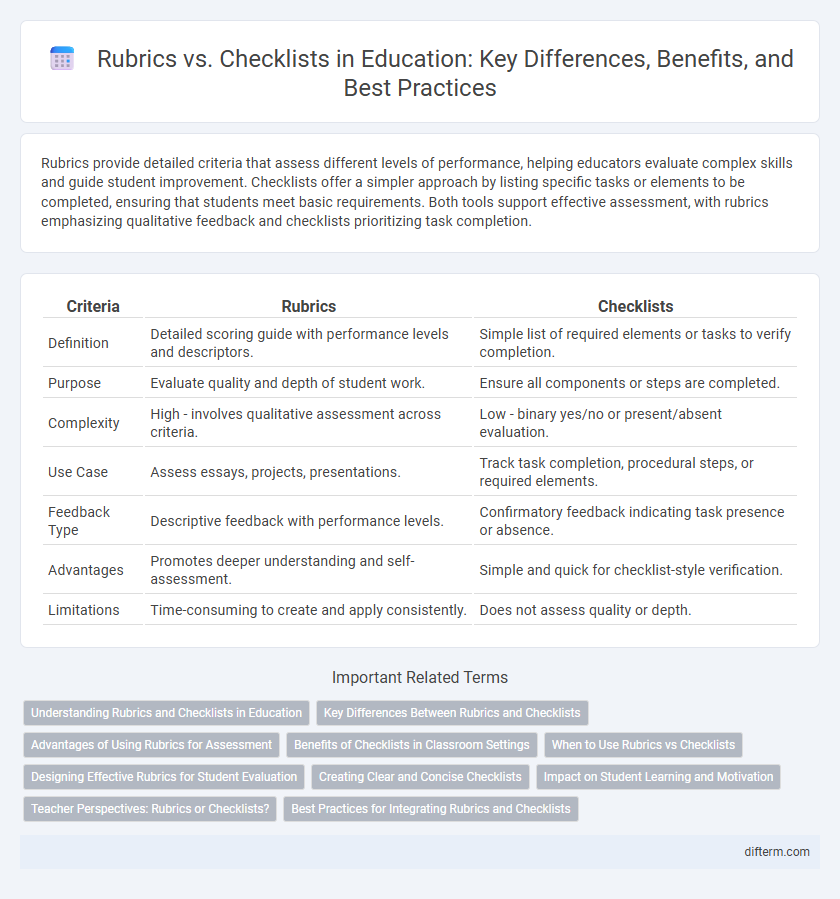Rubrics provide detailed criteria that assess different levels of performance, helping educators evaluate complex skills and guide student improvement. Checklists offer a simpler approach by listing specific tasks or elements to be completed, ensuring that students meet basic requirements. Both tools support effective assessment, with rubrics emphasizing qualitative feedback and checklists prioritizing task completion.
Table of Comparison
| Criteria | Rubrics | Checklists |
|---|---|---|
| Definition | Detailed scoring guide with performance levels and descriptors. | Simple list of required elements or tasks to verify completion. |
| Purpose | Evaluate quality and depth of student work. | Ensure all components or steps are completed. |
| Complexity | High - involves qualitative assessment across criteria. | Low - binary yes/no or present/absent evaluation. |
| Use Case | Assess essays, projects, presentations. | Track task completion, procedural steps, or required elements. |
| Feedback Type | Descriptive feedback with performance levels. | Confirmatory feedback indicating task presence or absence. |
| Advantages | Promotes deeper understanding and self-assessment. | Simple and quick for checklist-style verification. |
| Limitations | Time-consuming to create and apply consistently. | Does not assess quality or depth. |
Understanding Rubrics and Checklists in Education
Rubrics provide detailed criteria that assess the quality of student work across multiple levels, helping educators measure complex skills and guide improvement. Checklists organize tasks or skills into simple, binary criteria, making them effective for ensuring completion and basic competence. Combining rubrics and checklists enhances both comprehensive evaluation and efficient tracking of student progress in educational settings.
Key Differences Between Rubrics and Checklists
Rubrics provide detailed criteria with performance levels to evaluate complex skills or assignments, enabling nuanced feedback and consistent grading. Checklists list specific tasks or items to be completed, focusing on task completion rather than quality, making them ideal for simple or procedural assessments. Rubrics aid in formative and summative evaluations by assessing degrees of mastery, whereas checklists primarily ensure all required components are addressed.
Advantages of Using Rubrics for Assessment
Rubrics provide clear, detailed criteria that help students understand expectations and improve performance through specific feedback. They enable consistent and objective grading, reducing subjectivity compared to checklists. Rubrics also facilitate self-assessment and encourage deeper learning by emphasizing quality and critical thinking skills.
Benefits of Checklists in Classroom Settings
Checklists in classroom settings enhance student organization and task management by clearly outlining criteria, which promotes independence and accountability. They facilitate consistent and objective assessment, reducing teacher bias while providing immediate feedback for student improvement. Employing checklists streamlines classroom instruction, helping teachers monitor progress and identify learning gaps efficiently.
When to Use Rubrics vs Checklists
Rubrics are most effective for assessing complex, subjective tasks such as essays, projects, or presentations where multiple criteria and levels of performance need clear differentiation. Checklists are ideal for evaluating straightforward, binary tasks like attendance, completion of steps, or presence of required components. Choosing rubrics improves detailed feedback and scoring consistency, while checklists streamline quick verification and ensure task completion.
Designing Effective Rubrics for Student Evaluation
Designing effective rubrics for student evaluation enhances clarity and consistency by outlining specific criteria and performance levels. Rubrics provide detailed feedback on qualitative aspects such as critical thinking and creativity, unlike checklists that simply mark task completion. Clear, well-structured rubrics improve student understanding of expectations and support objective assessment practices in educational settings.
Creating Clear and Concise Checklists
Creating clear and concise checklists enhances student understanding by breaking down tasks into specific, manageable steps. Checklists provide measurable criteria that simplify assessment and guide learners through the expectations without ambiguity. Unlike rubrics, which offer detailed qualitative descriptors, checklists emphasize straightforward completion of essential components, making them ideal for tracking progress efficiently.
Impact on Student Learning and Motivation
Rubrics provide detailed criteria that guide students in understanding learning objectives, fostering self-assessment and deeper engagement with the material. Checklists offer straightforward task completion tracking, promoting organization but may limit critical thinking development. Rubrics enhance motivation by clarifying expectations and supporting personalized feedback, leading to improved student performance and learning outcomes.
Teacher Perspectives: Rubrics or Checklists?
Teachers often prefer rubrics for their detailed criteria that provide clear performance standards, enabling comprehensive student assessment and targeted feedback. Checklists are favored for their simplicity and efficiency, allowing quick verification of task completion and essential skill mastery. Both tools support varied instructional goals, with rubrics enhancing qualitative evaluation and checklists streamlining formative monitoring.
Best Practices for Integrating Rubrics and Checklists
Effective integration of rubrics and checklists enhances assessment accuracy and student understanding by clearly defining expectations and criteria. Implementing detailed rubrics alongside specific checklists promotes consistent grading and supports self-assessment, fostering deeper learning engagement. Aligning rubrics with checklist items ensures comprehensive feedback, improving instructional strategies and student outcomes.
rubrics vs checklists Infographic

 difterm.com
difterm.com